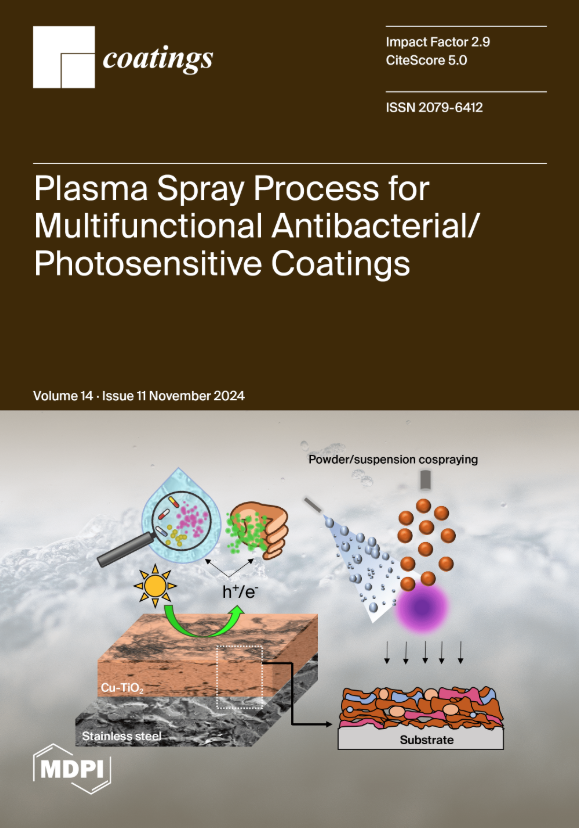电气设备保护用绝缘漆在温度和紫外线照射下的介电性能对比分析--是否有必要制定新标准?
IF 2.8
3区 材料科学
Q2 MATERIALS SCIENCE, COATINGS & FILMS
引用次数: 0
摘要
本文介绍了一些用于保护电气设备的环氧树脂漆、丙烯酸漆和聚氨酯漆在不同降解因子作用下的行为。选择的降解因子是温度和紫外线辐射。通过介电损耗角正切值(tg Delta)的变化以及傅立叶变换红外光谱(FTIR)和 TG DSC 分析来解释这些因素作用下涂料的行为。Tg Delta 被认为是参考介电特性,因为它能最好地模拟材料的功能。本文介绍的结果得出的结论是,每种涂料都有必要暴露于热循环和紫外线辐射下,以显示其在这些条件下使用的可能性。同时,对热稳定性的评估,即使是在较低的温度下(比我们进行测试的温度低)和/或较短的时间内,对于将涂料归入隔热等级也是非常重要的。这项工作中的测试为我们提供了有关所分析的三种涂料的以下信息:S3 对热循环的耐受性最高,其次是 S2,然后是 S1;热耐久性测试将聚氨酯涂料(S3)归入隔热等级 E,将环氧涂料(S1)归入隔热等级 B;抗紫外线辐射测试将最好的涂料定为丙烯酸涂料(S2),最差的定为聚氨酯涂料(S3)。因此可以说,在需要保护膜耐高温的应用中,建议使用 S3 涂料(聚氨酯),而在保护膜受紫外线辐射影响时间较长的应用中,建议使用编码涂料 S2(丙烯酸)。本文中介绍的结果得出这样的结论:必须根据每种涂料的具体用途,对其进行模拟室外使用条件下的热循环暴露和紫外线辐射条件下的适应性测试,并且必须仔细评估介电特性,因为即使暴露温度较低和/或暴露时间较短,介电特性也可能达到公认的极限值(例如热稳定性评估)。实验工作的结论必须适用于不同类型的电气绝缘漆,也许有必要制定新的标准来评估漆在使用条件下的行为,同时需要将漆与传统的聚合物绝缘系统分开处理。本文章由计算机程序翻译,如有差异,请以英文原文为准。
Comparative Analysis of Dielectric Behavior under Temperature and UV Radiation Exposure of Insulating Paints for Electrical Equipment Protection—The Necessity of a New Standard?
This paper describes the behavior of some epoxy, acrylic and polyurethane paints used in the protection of electrical equipment under the action of different degradation factors. The degradation factors chosen were temperature and UV radiation. The behavior of the paints under the action of these factors was interpreted by the variation of the tangent of the dielectric loss angle (tg Delta) as well as by FTIR and TG DSC analyses. Tg Delta was considered the reference dielectric characteristic because it best simulates the functionality of the material. The results presented in this paper lead to the conclusion that exposure to thermal cycles and UV radiation is necessary for each paint to give indications about their possibility of use in these conditions. At the same time, the evaluation of thermal stability, even if the exposure is at lower temperatures (than those at which we performed the tests) and/or for shorter periods, is very important for placing the paint in an insulation class. The tests that were the subject of this work provide us with the following information about the three types of paints analyzed: the highest resistance to thermal cycles is presented by S3, followed by S2 and then S1; thermal endurance tests place the polyurethane paint (S3) in insulation class E and the epoxy paint (S1) in insulation class B; and the tests to determine resistance to UV radiation qualify the best paint as acrylic (S2) and the worst as polyurethane (S3). Thus, it can be said that in applications where it is necessary for the protective film to withstand high temperatures, the use of S3 paint (polyurethane) is recommended, and in applications where the films are kept under the influence of UV radiation for a longer time, it is recommended to use coded paint S2 (acrylic). The results presented in this paper lead to the conclusion that the exposure to thermal cycles simulating the use in outdoor conditions and the resilience of paints under UV radiation conditions must be performed for each paint according to its specific use, and the dielectric characteristics must be carefully evaluated because they can reach values under the accepted limit—e.g., thermal stability evaluation—even if the exposure is at lower temperatures and/or for shorter periods. The conclusions of the experimental work must be generalized at different types of electrical insulating paints, and maybe a new standard is necessary to assess the paints’ behavior under usage conditions, with the paints needing to be treated separately from the classical polymeric insulation systems.
求助全文
通过发布文献求助,成功后即可免费获取论文全文。
去求助
来源期刊

Coatings
Materials Science-Surfaces, Coatings and Films
CiteScore
5.00
自引率
11.80%
发文量
1657
审稿时长
1.4 months
期刊介绍:
Coatings is an international, peer-reviewed open access journal of coatings and surface engineering. It publishes reviews, research articles, communications and technical notes. Our aim is to encourage scientists to publish their experimental and theoretical results in as much detail as possible. There is no restriction on the length of the papers. Full experimental and/or methodical details must be provided. There are, in addition, unique features of this journal:
* manuscripts regarding research proposals and research ideas will be particularly welcomed
* electronic files or software regarding the full details of the calculation and experimental procedure - if unable to be published in a normal way - can be deposited as supplementary material
 求助内容:
求助内容: 应助结果提醒方式:
应助结果提醒方式:


